Spotted Hyenas: Gender Bending, Enchanting, Formidable
They crunch bones like popcorn. The females sport pseudo-penises. And the people who study these animals just adore them. A tour of the hidden life of the spotted hyena.
By Vicki Croke
They can crunch bone, one researcher says, like popcorn.
The females have penises (technically “pseudo-penises”), which become erect with excitement, and through which they give birth.
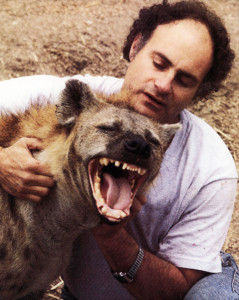
Laurence Frank with his beloved Tuffie, the hyena who always greeted him with her baby sounds. The California colony where Tuffie lived will be closing within weeks.
Where other female mammals have vaginas, female spotted hyenas have something that looks like a scrotum.
They make devoted mothers.
They are born with their eyes wide open and their canine teeth exposed—ready to fight a twin to the death if necessary.
Though they are often perceived as scavengers, they hunt and kill more than lions do and scavenge less.
They can eat anthrax without getting sick.
They are so full of personality and capable, it seems, of such affection, that researchers who study them closely are enchanted with them.
Spotted hyenas are magnificent animals, different from other mammals in several respects. And scientists are still counting the ways as we continue to learn more about them.
Krista Glickman communing with a young female hyena. Courtesy of Stephen Glickman.
That’s why many experts are mourning the loss of the world’s only research colony of captive spotted hyenas. It’s been part of the University of California’s Berkeley campus (high in the hills) for 30 years. In collaboration with field biologists working in the wild, a network of researchers at the colony has acted as hyena code breakers. They’ve been studying the animals’ unusual genitalia, their signature vocalizations, and their instances of siblicide (unusual in mammals), among other things.
Listen to Vicki talk to Jeremy Hobson about these fascinating creatures and the closing of the Berkeley facility on Here & Now
The colony began with carnivore ecologist Laurence Frank and psychologist Stephen Glickman. Frank studied spotted hyenas in the Masai Mara in Kenya from the late 1970s till the late 1990s. And in 1985, he and Glickman ended up bringing 20 cubs back to Berkeley. They bottle-fed the babies and established the group.
Initially, it was set up for one purpose: to understand the role of hormones on behavior and the female’s anatomy.
Females hyenas, it turns out, have a lot of male hormone. Scientist know that if you give other female mammals, including humans, a lot of male hormone, their clitorises will become enlarged. (In hyenas, the female version is nearly indistinguishable from that of the male.)
With spotted hyenas, a complex interaction of hormones occurs in the womb with the developing fetus. But the interesting thing is those hormones don’t tell the whole story of how it is that female hyenas have those “penises.”
Some endocrinologists working in Berkeley discovered that they could block the male hormones in these hyenas, and the females would still end up with a pseudo-penis. Why this is, is not clear, but the work is being shut down before the complex phenomenon has been fully plotted out.
Steve Glickman, professor emeritus, who began the study with Laurence years ago, explains:
“Some of the endocrinologists have obtained preliminary data suggesting that you don’t need male hormones or androgens to create masculine genitalia.”
That means that the “how” of that penis isn’t so clear-cut. The “why” may be a little more apparent.
Those penises and high levels of male hormone (whatever the complicated chemical and biological interplay is) could make female hyenas better mothers. And they are really good mothers.
Spotted hyenas live in big clans—as many as 80 animals to a clan. And they are extremely hierarchical. Alpha females at the top, then lower ranking females, then males at the very bottom.
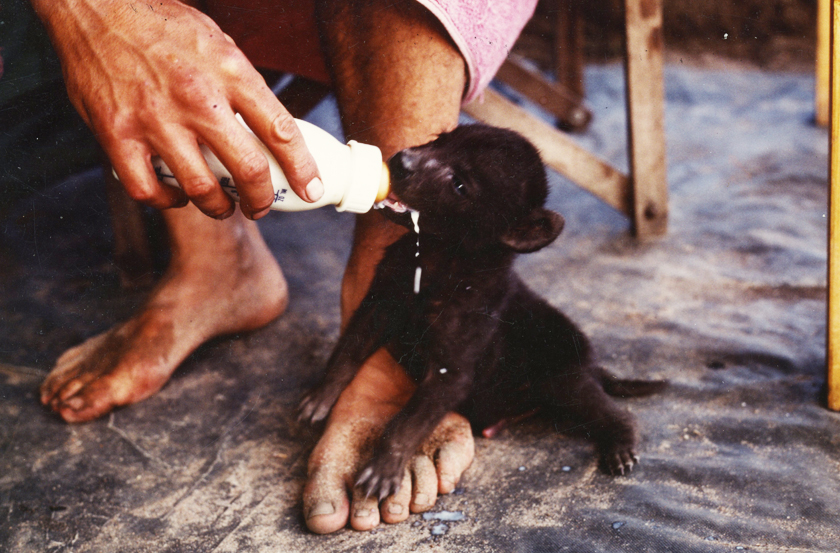
Most endearing hyena pictures ever: Laurence Frank bottle feeds Tuffie. (Spotted hyenas are black when very young.) Courtesy of Laurence Frank.
The girls are bigger and more aggressive than the males, and that’s important at a kill where higher ranking animals and their offspring get the best seats at the table. These animals can bolt down 40 pounds of food at a sitting. The alpha female and her children get a good share of meat and sometimes the lower ranking males have to make due with skin and bones. (The good news is that they can basically digest anything—eating every part of a 450-pound wildebeest, regurgitating the hair and hooves later.)
But the fact is that those alpha babies can be twice the size at 6 month of a low ranking cub. The lesson is that the bigger and tougher you are in hyena society, the better you and your children eat at the communal table.
So maybe the females needed lots of male hormone to accomplish that.
That’s probably the best and most accepted theory out there. As Laurence Frank says:
“The original selection for this entire peculiar set of characteristics was not to give a female funny genitalia which would make it difficult for her to give birth, but that the actual selective pressures, the natural pressures, was to make for a more aggressive female who would prosper in a highly, highly competitive social environment.”
If that’s right, it tells us the upside of the pseudo-penis. But there is a terrible downside.
Giving birth through it is a challenge. So much so that there is a high mortality rate for mothers and babies during labor. A penis is just not a good birth canal. Greg Miller, of the journal Science, described it as pushing a golf ball through a soda straw.
While we don’t know everything about spotted hyenas, we do know how much we’ve gotten wrong about them in the past.
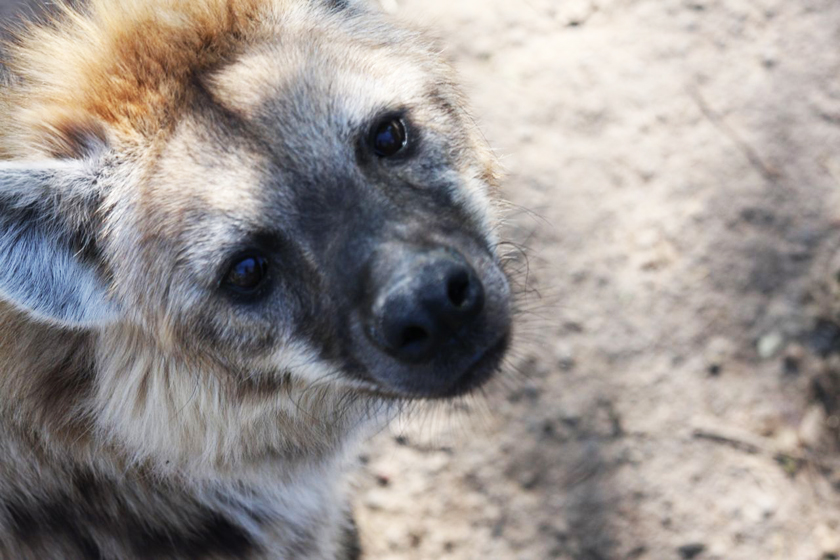
Laurence Frank says that when he looks at a hyena he sees “a deep, warm, nurturing, complex personality with bottomless brown eyes.” He adds, ” I just love hyenas.” Photo: courtesy of Frederic Theunissen.
Since the time of Aristotle, most humans have loathed hyenas. Africans who live around them have pretty good reason—they’re tough predators with one of the strongest bites in the mammal world. But for Westerners—hyenas have been considered “unclean,” hermaphrodites, scavengers, and grave robbers. All those things are untrue or exaggerated. Hyenas make their own kills 95 percent of the time—that’s more than lions, by the way. They scavenge less than lions do. And as Laurence Frank said, what’s wrong with scavenging? It’s what we do every time we go to the grocery store.
Hyenas will eat dead things, including humans when given the chance. After all, they are the garbage disposals of the savanna. They peel away keratin on horns of antelope to get at the bone underneath. And they can continue to feed on a big carcass for weeks even as it rots.
But the hyena’s ability to digest practically anything is part of their greatness. Scientists want to know how it is they can ingest deadly anthrax without even becoming sick. Their immune systems do appear to be quite extraordinary–they seem to avoid diseases like rabies and distemper that kill other big predators.
Spotted hyenas are the largest of the hyena species, which include the brown and striped hyenas. Though they can weigh up to about 190 pounds, usually they’re about 130 or 140 pounds. They are top-loaded, with well-built neck and shoulders, sloping back and shorter hind legs. They have kind of a doggie face, but are more closely related to cats.
They are also considered to be very smart—their intelligence has been compared to that of baboons. Researchers have witnessed them deceiving each other (an alarm call given by a low-ranking hyena to make the higher-ranking ones move away from a carcass long enough to get a bite, for instance). And we humans seem to see deceit as a real marker of intelligence.
And they are highly social, living in complex fission-fusion clans, keeping up stable relationships for decades.
Spotted hyenas do things we might be squeamish about. It turns out that in the den, hyena babies can fight vigorously and occasionally kill one another.
Among their wonders, spotted hyenas produce a vast repertoire of sounds. It makes sense since they are social hunters who work in darkness. They communicate a lot by sound to one another.
Researcher Frederic Theunissen shared some recordings:
The first is that famous giggle:
As Laurence Frank says, a laughing hyena is not a happy hyena. The giggle conveys fear or nervousness. Usually an intense social situation.
And here is what’s called a slow whoop that is providing information from one individual to others in the clan:
Those vocalizations are providing a lot of information for other hyenas, who are listening, it seems.
With so much left to learn about hyenas, why is the colony closing down?
Odd as it may seem, the colony’s funding came largely from the National Institute of Mental Health. The interest was in the connection between hormone levels and aggression. That’s something that could help us in our understanding of mammal biology, which includes us. When that funding ran out after 22 years, there was some money from the National Science Foundation, but that’s gone now too.
It’s taken the staff a long time to find zoos and sanctuaries to take the animals.
Steve Glickman, now professor emeritus, says that he and others are so attached to the hyenas that they’ve spent more time trying to find good homes for them than looking for funding to keep the program going. As of the middle of September, they’ll all be gone.
It’s a personal loss to the people who’ve worked there. Laurence Frank describes his work with the hyenas in joyous terms:
“For me the greatest part of this whole experience was getting to know these hyenas as individuals, and basically as their mommy. They are such cool, interesting, engaging animals as individuals. They have such personalities. They are so smart and they have such complex social interactions. They’re just absolutely delightful animals to deal with on a personal, intimate level.”
Both Steve Glickman and Laurence Frank speak with tenderness about one of their favorite females, Tuffie. Frank describes his reunions with her:
“My dearest old girl, Tuffie, who I probably got when she was three days old, when she was twenty-five years old and really sort of at the end of her life, I would go into the cage with her and she would still make little baby noises and hurl herself at me in great joy and cuddle on the floor. Just an extraordinary lifelong relationship with a large, potentially dangerous animal.”
The colony’s bottle-fed hyenas made such reliable and loyal companions that Laurence feels that if the world had tipped in a slightly different direction, we’d have pet hyenas now instead of dogs.
If that were the case, instead of wagging tails and yips of joy, maybe when we got home from work, this is what we’d hear. It’s what spotted hyenas sound like when bonding with one another:



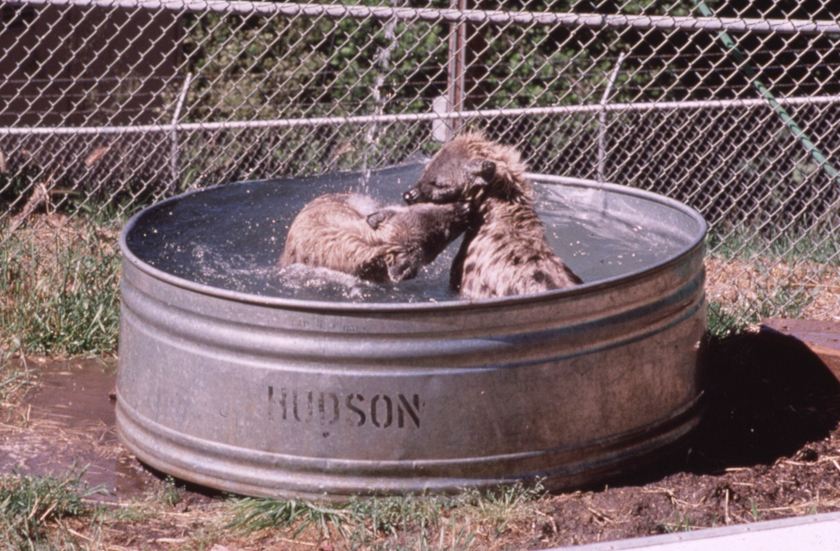
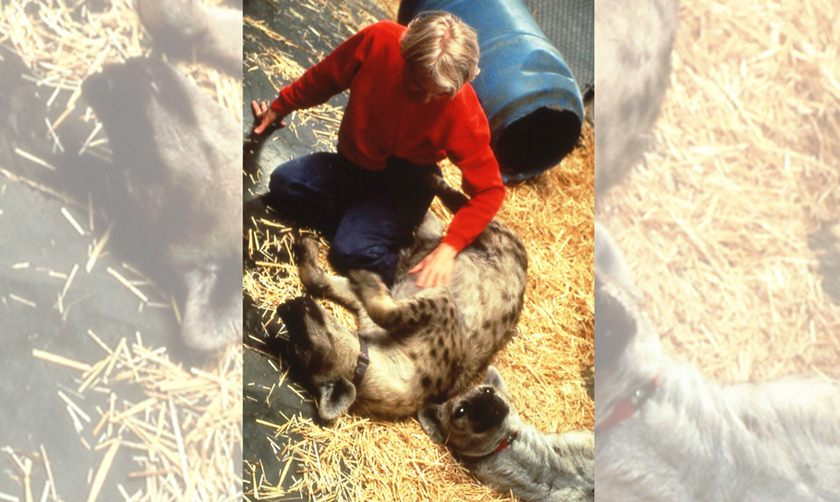
3 Responses to “Spotted Hyenas: Gender Bending, Enchanting, Formidable”
Thanks for this article. I have unique memories of running on the fire trails in the Berkeley hills high above the Cal campus and hearing the hyena vocalizations. It was a sound that made one pick up the pace!
This is a very interesting and informative article; however, what saddens me is that these animals have formed intense bonds with their conspecifics and their caretakers; if the colony is disbanded, won’t the animals suffer from grief? Too sad. They should be kept together for life.
So sad
Comments are closed.